The iPhone 7 and iPhone 7 Plus Review: Iterating on a Flagship
by Joshua Ho & Brandon Chester on October 10, 2016 8:00 AM EST- Posted in
- Smartphones
- Apple
- Mobile
- iOS
- iOS 10
- iPhone 7
- iPhone 7 Plus
Battery Life
As-is, one of the most important factors for upgrading a smartphone remains battery life, due to a combination of inherent demand for a phone that can last 2-3 days of use and applications that demand enormous amounts of performance over long periods of time. Apps like WeChat are fairly notorious for holding wakelocks on Android and never really stopping background resource usage so there’s also an element of OS optimization that goes with keeping real-world in battery life up to expectations.
In order to test these things, we’ve spent the past year developing and validating a new web browsing battery life test which updates the sites used and introduces a scrolling component which attempts to better model how a number of tasks are not simply race to sleep and contain a steady-state component. We’ve also updated our rundown tests to better reflect reality and maintain appropriate loads as some devices with high-end SoCs and low display resolution were outpacing our testing. As always, all displays are set to 200 nits with location and other background services disabled to reach a useful relative comparison.

Looking at our WiFi web browsing test, it’s genuinely ridiculous how well the iPhone 7 and 7 Plus perform in this test. The iPhone 7 Plus is definitely down on battery life compared to the Galaxy S7 Edge, but it’s within 5% despite using a battery that’s almost 20% smaller. The iPhone 7 is actually comparable in battery life to the iPhone 7 Plus, and is significantly above the Galaxy S7 with Exynos 8890. Of course, the iPhone 7 has a significantly lower resolution display and a smaller battery, but the nature of smartphone design is that larger devices will generally have better battery life because the board area needed remains mostly constant while the amount of area for battery increases. The iPhone 7 has significantly improved in battery life here, likely due to a combination of A10 Fusion's power optimizations – particularly the small CPU cores – and the removal of the headphone jack, which teardown photos show to have been partially replaced with the battery. However if you do the math efficiency sees a relatively minor uplift.
One other interesting point is that Brandon accidentally ran the battery test on his iPhone 7 with a Safari Content Blocker enabled, which blocked all the ads on the sites that the test visits. In doing so, battery life rose from the normal result of 9.22 hours to 10.03 hours, demonstrating how the increased workload and long-running network requests from ads and trackers really impacts a smartphone's battery life. It's also worth noting that our test constantly cycles through pages, so if you spend a lot of time on a single page with ads you could see an even greater difference.
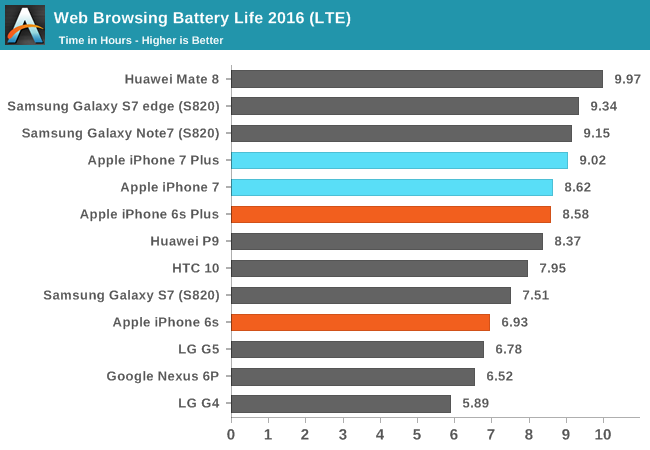
Moving on to LTE battery life the iPhone 7 and 7 Plus both slip a bit, but remain impressive. I suspect that the 20nm Qualcomm modem here is not well-equipped to handle the endless stream of ads that is increasingly a part of most websites. As ads tend to stream in incredibly slowly, the standby power of the modem is a significant factor. Snapdragon 820 devices don’t see nearly the impact here that the iPhone 7 and 7 Plus as their modem is on 14LPP rather than 20SoC. The iPhone 7 remains above the S820 Galaxy S7, but the iPhone 7 Plus is fairly comparable to the iPhone 6s Plus in battery life on LTE.

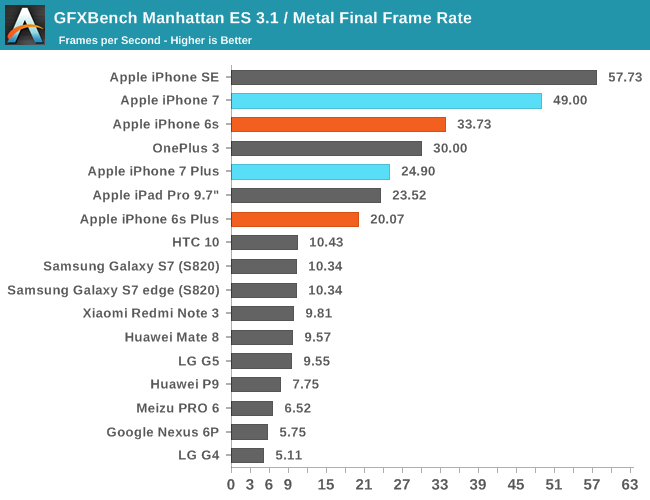
Moving past the web browsing test we use we can take a look at how the iPhone 7 Plus throttles. Unfortunately Basemark OS II was basically broken in this regard for the CPU rundown test so we can only look at how it behaves on Manhattan 3.1, but it's interesting to see how the GPU performance drops about 40% for the iPhone 7 Plus while the iPhone 7 throttles around 20%, because even Manhattan 3.1 is pegged to vsync which means that the GPU can spend much more time idling once a given frame is rendered. It's probably not a surprise here but the iPhone 7 just doesn't last very long here because battery life is strongly SoC-bound. If you attempted to plot battery life as a function of overall SoC utilization, it's entirely possible that the iPhone 7 might last longer than the 7 Plus at the lower bound for utilization, but as soon as you go past web browsing and similarly "light" tasks the 7 Plus and most phablets are going to strongly outperform such a small phone. Here the larger battery helps to get the iPhone 7 Plus nearly another hour of battery life when the SoC is under full, continuous load.
Charge Time
As usual, while battery life is the salient characteristic that determines overall mobility, it’s important to not ignore charge time as there are a number of edge cases where charging has a significant impact on overall mobility. In order to test this we use power measurements at the wall and measure the time it takes from the moment that the charger is plugged in to the moment that it falls below a pre-determined draw from the wall. While this isn’t perfect due to varying levels of DC conversion efficiency and different methods of trickle charging, this method provides at least a reasonable approximation of how long it will take to charge a device.
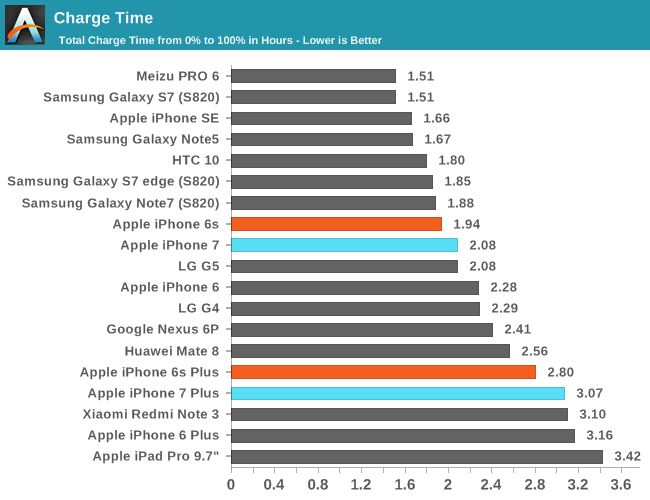
In the case of the iPhone 7 and 7 Plus, Apple continues to ship their standard 5W chargers for US variants. Looking at the results, it’s probably obvious that at least in the case of the iPhone 7 Plus, there is a very real need for Apple to start shipping something with faster charging, as the standard 5W charger takes a full hour longer than most of its competition to charge to 100%. Even the iPhone 7 could use a higher power charger here as using the device while it is charging will significantly impact the charging rate as the charger cannot supply enough power to the board while also charging the battery. And in the case of both phones, the lack of a high power charger doesn't just draw out the total charge time, but it also precludes rapid charging (partially charging a depleted phone very quickly) as well.
It would really be prudent for Apple to start to transitioning to higher power AC adapters at this point. This doesn’t take away from how impressive battery life is, but overall mobility isn’t going to be better than the competition unless you go out of your way to buy an iPad charger.


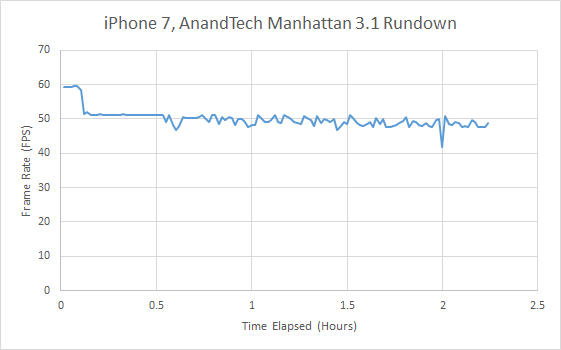
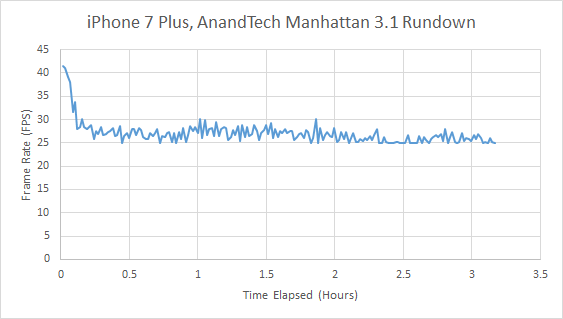
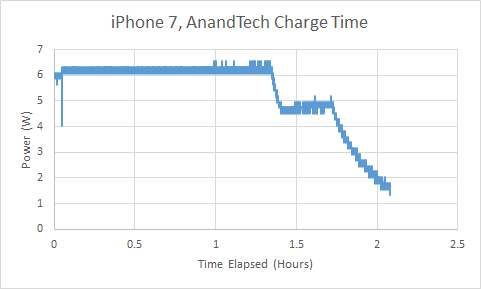
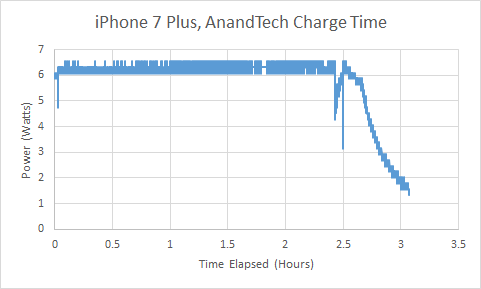








377 Comments
View All Comments
GTRagnarok - Monday, October 10, 2016 - link
Yeah, that statement made no sense. He said it was fairly thick relative to the iPhone 6S which was thicker at 7.1mm so...???lilmoe - Monday, October 10, 2016 - link
The whole thing about thickness and "freezing motion" made no sense. He probably didn't have anything else to prove his "point" that iPhones faced little competition in 2014/15.The context of AT reviews has been broken for a while. Just like someone else here suggested; they should only focus on reviewing parts of tech in which they have more knowledge about and accurate tools to measure. Hopefully using better "tools" than browser benchmarks (!).
Ryan Smith - Tuesday, October 11, 2016 - link
For better or worse, you will be seeing browser benchmarks for years to come. As few developers care to tackle cross-platform system benchmarks, we aren't left with very many tools to use. Never mind the fact that browser performance is still a major part of the overall smartphone experience.lilmoe - Tuesday, October 11, 2016 - link
Your perception and truth and credibility is up to you. But if it is worth anything, I'd suggest you change the title/section to "Mobile Safari Performance (vs Mobile Chrome)", or scratch it off entirely.What you're currently doing is provide false information (and lies) to your readers, unless the purpose of this site has changed to "providing fanboys and fools with fuel for their petty flamewars". You're making yourself look like an Apple shill, or worse, you're providing a cover up for Google's failings in optimizing their browser and platform for the latest Cortex and custom cores.
If you have no tools for accurate measurement, like you just stated, then you should skip this section all together or narrow it down to Apple SoC comparisons ONLY, with a big fat disclaimer explaining why that data CANNOT be applied/compared with other SoCs and platforms.
lilmoe - Tuesday, October 11, 2016 - link
***Your perception *of* truth and credibility is up to youblackcrayon - Tuesday, October 11, 2016 - link
Yes, they should have included GeekBench as a cross platform SoC test. THAT would have shown that... oops... The A10 still blows away everything else in single core by a huge margin.From what I've seen, using other browsers on Android doesn't help much. But if you'd like to point to some benchmarks we're all eyes.
UtilityMax - Wednesday, October 12, 2016 - link
The smartphone SoCs have reached a point where their performance differences are pretty much superfluous. Yeah, we all know that the Apple SoC is significantly better than Snapdragon 820. But that's just like saying that if you bring to a race track Lamborghini, Ferrari, and McLaren and race them, then you will find out that one car is fast than the rest, which is somewhat irrelevant outside of such racetrack. The truth is that smartphone SoCs have gotten to be fast enough that a three year old Nexus 5 is still fast and more than adequate for day to day duties. On the other hand, apple's deletion of the headphone 3.5mm jack and its refusal to allow the users to upload the multimedia into the device bypassing the iTunes GARBAGE is a big loss. For these reasons, in my book, a 200USD Moto G is still a lot better than an iPhone 7, even if the iPhone 7 was also sold for 200USD.ex2bot - Wednesday, October 12, 2016 - link
I can get the multimedia to my Apple phone without the iTunes GARBAGE. Maybe you have a different model from me or something. ;)CloudWiz - Thursday, October 13, 2016 - link
Which is why both XDA and Anandtech have found that the Note 7 was incredibly slow to load apps in Discomark, which definitely impacts daily usage.ex2bot - Wednesday, October 12, 2016 - link
Forget GeekBench. Stick with Antutu. More representative.